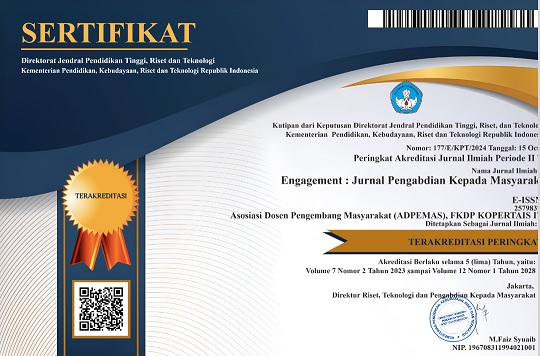Teak Leaf Tea Product Development in Kebontunggul Village, Mojokerto
Abstract
Kebontunggul Village in Mojokerto, with its abundant natural resources, has a golden opportunity to develop into an herbal village. The fertile land in this village serves as a habitat for teak plants, producing leaves rich in bioactive compounds. A collaboration between the University of Surabaya, Widya Mandala Surabaya Catholic University, Village-owned Enterprises, the Tourism Awareness Group, and the Family Welfare and Empowerment Organization, facilitated by the Ministry of Education and Culture, processed the teak leaves into powder and tea. This collaboration aimed to improve public health and open up economic opportunities for the local community. The process included socialization, training, and evaluation, with the Participation Rural Appraisal (PRA) method employed to ensure active community participation at every stage, from identifying the potential of natural resources to the production and marketing of the products. As a result, the village has successfully produced teak leaf powder and teak leaf tea, which have started to be commercialized.
Downloads
References
Kaur, G.. Study and Analysis of Lecture Model of Teaching. International Journal of Educational Planning & Administration, 1(1) (2011): 9-13. https://www.ripublication.com/ijepa/ijepav1n1_001.pdf
Koch, Zagórska, Marzec, & Kukula-Koch. Applications of Tea (Camellia sinensis) and its Active Constituents in Cosmetics. Molecules, 24(23), (2019): 4277. https://doi.org/10.3390/molecules24234277
Kunst, A. Attitudes towards food in Indonesia as of March 2023. Statista. (2023). https://www.statista.com/forecasts/1348196/attitudes-towards-food-in-indonesia (Diakses pada 9 November 2023)
Lagawa, I. N. C., Kencana, P. K. D., & Aviantara, I. G. N. A. The Effect of Withering Time and Drying Temperature on The Characteristics of Herbal Tea Bamboo Leaves “Tabah” (Gigantochloa nigrociliata BUSE-KURZ). Jurnal BETA (Biosistem danTeknikPertanian), 8(2), (2020): 223-230. https://jurnal.harianregional.com/beta/id-54062
Phaniendra, A., Jestadi, D. B., & Periyasamy, L. Free Radicals: Properties, Sources, Targets, and Their Implication in Various Diseases. Indian Journal of Clinical Biochemistry, 30(1), (2015):11–26. https://doi.org/10.1007/s12291-014-0446-0
Plumeriastuti, H., Budiastuti, B., Effendi, M., & Budiarto, B. Identification of bioactive compound of the essential oils of Cinnamomum burmannii from several areas in Indonesia by gas chromatography-mass spectrometry method for antidiabetic potential. National Journal of Physiology, Pharmacy and Pharmacology, 0, 1. (2019). https://doi.org/10.5455/njppp.2019.9.1236702022019
Romero, J.E. & Wonoseputro, C. Fasilitas Wisata Edukasi Tanaman Herbal Kebontunggul di Kabupaten Mojokerto. Jurnal eDimensi Arsitektur, 11(1), (2023): 481-488. https://publication.petra.ac.id/index.php/teknik-arsitektur/article/view/13721
Shopee. Kantung teh celup kosong dan tali. Website: https://id.shp.ee/7cMZ1Cj (Diakses pada 28 April 2024)
Sontakki, B., Venkatesan, P., & Rao, V. K. J. R. J. Participatory Rural Appraisal (PRA): Tools & Techniques. ResearchGate. (2019). https://www.researchgate.net/publication/336230869_Participatory_Rural_AppraisalPRATools_Techniques
Sucianti, A., Yusa, N. M., & Sugitha, I. M. Effect of Drying Temperature On Antioxidant Activity and Characteristics Herbal Teabag of Mint Leaves (Mentha piperita L.). Itepa: Jurnal llmu dan Teknologi Pangan, 10(3), (2021): 378-388. https://www.scribd.com/document/580314787/82289-553-254238-1-10-20220112
Suryanti, V., Kusumaningsih, T., Marliyana, S. D., Setyono, H. A., & Trisnawati, E. W. Identification of active compounds and antioxidant activity of teak (Tectona grandis) leaves. Biodiversitas, 21(3), (2020): 946-952. https://doi.org/10.13057/biodiv/d210313
Susanti, Kiki Anasya., Pengaruh Influencer Dr. Zaidul Akbar Terhadap Perilaku Gaya Hidup Sehat (Healthy Lifestyle) Konsumen. (2021). https://repository.uir.ac.id/13162/1/175210432.pdf
Tokopedia. Yutakachi bubuk kayu manis. Website: https://tokopedia.link/cz4PG0OzaJb (Diakses pada 28 April 2024)
Newby, T. J., et.al. Educational technology for teaching and learning (4th ed). London: Pearson. (2010). https://books.google.co.id/books/about/Educational_Technology_for_Teaching_and.html?id=2JnmQwAACAAJ&redir_esc=y
Sutanto T. A., et.al. The Development of Teak Leaf Cookies for BUMDes Gajah Mada, Pokdarwis, and PKK in Kebontunggul Village, Mojokerto. Amalee 5(1), (2024): 321-336. https://doi.org/10.37680/amalee.v5i1.4126
Copyright (c) 2024 Engagement: Jurnal Pengabdian Kepada Masyarakat

This work is licensed under a Creative Commons Attribution-ShareAlike 4.0 International License.






.png)




